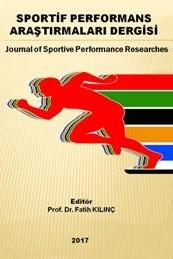Türk Milli Erkek Halter Takımı'nın Müsabaka Kaldırışlarındaki Başarı Oranlarının İlk Üç Dereceye Giren Ülkelerle Karşılaştırılması
Amaç: Bu çalışmanın amacı, Erkek Halter Milli Takımı’nın bir müsabakada kural olarak 6 hak ile sınırlanan koparma ve silkme kaldırışlarındaki başarı oranlarının, takım sıralamasında ilk üç dereceye giren ülkelerin başarılı kaldırış oranlarıyla karşılaştırmaktır. Yöntem: Çalışmada Erkek Halter Milli Takımı’nın tam takım olarak katıldığı, 4 Dünya Şampiyonası ve 5 Avrupa Şampiyonası müsabaka sonucu veri olarak kullanılmıştır. Erkek Halter Milli Takımı’nın başarılı kaldırış frekansları ile dereceye giren ülkelerin başarılı kaldırış frekansları Ki-kare testi ile karşılaştırılmıştır.Bulgular: Erkek Halter Milli Takımı ile takım sıralamasında ilk üç dereceye giren ülkelerin başarılı kaldırışlarının istatistiki olarak önemli düzeyde farklılaştığı görülmüştür. Bu farklılığın; koparma hareketinde 2. denemeler (p< .05), silkme hareketinde ise 1. denemeler (p< .05). 2. denemeler (p< .05) ve 3. denemeler ’den (p< .05) kaynaklandığı belirlenmiştir. Sonuç: Sonuç olarak, Erkek Halter Milli Takımı’nın müsabaka başarılı kaldırışlarının, takım olarak ilk üç dereceye giren ülkelere göre daha düşük olduğu ortaya çıkmıştır. Bu farklılıkların koparma ve silkme tekniklerinin bazı özelliklerine bağlı olarak psikolojik ve fizyolojik faktörlerden kaynaklanabileceği düşünülmektedir.
Anahtar Kelimeler:
Halter, Koparma, Silkme, Halter Milli Takımı
The success rates of Turkish Weightlifting National Team in the competition attempts: Comparison with the first three countries
Objective: The aim of this study is to compare the successful lifting of the Men's Weightlifting National Team in the snatch and clean & jerk movements, which is limited to 6 attempts as a rule in competition, to the successful lifts of the first three countries in the team rankings.Method: In the study, the results of the four World Championships and five European Championships, in which the senior male weightlifting national team athletes participated as a full team, were used as data. As the research method, source scanning method was used. The successful lift frequencies of the senior Turkish National Weightlifting Team and the total successful lift frequencies of the countries that entered the top 3 ranks in these competitions were compared with the Chi-square test. Results: The statistically significant differences were found in all snatch and clean&jerk attempts, the 2nd snatch attempts (p< .05) and in the movements of clean&jerk attemts, 1st lifts (p< .05), 2nd lifts (p< .05), 3nd lifts (p< .05).Conclusion: As a result, it was seen that the successful lifting performance of the senior male weightlifting national team athletes was lower than those of the first three countries in the championship. It is thought that these differences may be due to the reasons related to psychological and physiological factors depending on some characteristics of the breakout and shrinking techniques.
Keywords:
Turkish National Weightlifting Team, weightlifting, snatch, clean&jerk,
___
- Antonio, U. (2011). Weightlifting. Sport for all sports/Antonio Urso. Copyright: Calzetti & Mariucci Publishers: Topografia Mancini–May 2011 р.
- Chiu, L. Z., & Schilling, B. K. (2005). A primer on weightlifting: From sport to sports training. Strength and Conditioning Journal, 27(1), 42.
- Daniel, T. M., & Constantin, M. D. (2014). Concentration Time in 53 kg Women's Weightlifting, Clean and Jerk Style. Procedia-Social and Behavioral Sciences, 117, 352-356.
- Elemiri, A., & Ahmet, A. (2014). Mental toughness and its relationship to the achievement level of the weightlifters in Egypt. Turkish Journal of Sport and Exercise, 16(2), 63-69.
- Fry, A. C., Stone, M. H., Thrush, J. T., & Fleck, S. J. (1995). Precompetition Training Sessions Enhance Competitive Performance of High Anxiety Junior Weightlifters. The Journal of Strength & Conditioning Research, 9(1), 37-42.
- Garhammer, J., & Takano, B. (1992). Training for weightlifting. Strength and power in sport, 11, 357-369.
- Harbili, E., & Arıtan, S. (2006). Koparma Tekniğinin Biyomekaniği. Spor Bilimleri Dergisi, 17(3), 124-142.
- Hopkins, W. G. (2004). How to interpret changes in an athletic performance test. Sportscience, 8(1), 1-7.
- Hopkins, W. G., & Hewson, D. J. (2001). Variability of competitive performance of distance runners. Medicine and science in sports and exercise, 33(9), 1588-1592.
- Kılınç, F. (2008). An intensive combined training program modulates physical, physiological, biomotoric, and technical parameters in women basketball players. The Journal of Strength & Conditioning Research, 22(6), 1769-1778.
- Koruç, Z. (2013). Olimpik Halterde Yarışma Sendromuna Psikolojik Yaklaşımlar. 5. Antrenman Bilimi Kongresi Kitabı Du & Se Ajans 2013, 52.
- McGuigan, M. R., & Kane, M. K. (2004). Reliability of performance of elite Olympic weightlifters. The Journal of Strength & Conditioning Research, 18(3), 650-653.
- Mendez-Villanueva, A., Mujika, I., & Bishop, D. (2010). Variability of Competitive Performance Assessment of Elite Surfboard Riders. The Journal of Strength & Conditioning Research, 24(1), 135-139. doi:10.1519/JSC.0b013e3181a61a3a
- Pyne, D. B., Trewin, C. B., & Hopkins, W. G. (2004). Progression and variability of competitive performance of Olympic swimmers. Journal of sports sciences, 22(7), 613-620.
- Storey, A., & Smith, H. K. (2012). Unique aspects of competitive weightlifting: performance, training and physiology. Sports Med, 42(9), 769-790. doi:10.2165/11633000-000000000-00000
- Tanyıldızı, N. İ. (2013). Halkla İlişkilerde Sosyal Sorumluluk Uygulama Alanı Olarak Sanat Faaliyetleri (Akbank, Garanti Bankası ve İş Bankası Örneği). İnönü Üniversitesi Sanat ve Tasarım Dergisi, 3(8).
- ISSN: 1308-6669
- Başlangıç: 2009
- Yayıncı: Süleyman Demirel Üniversitesi
